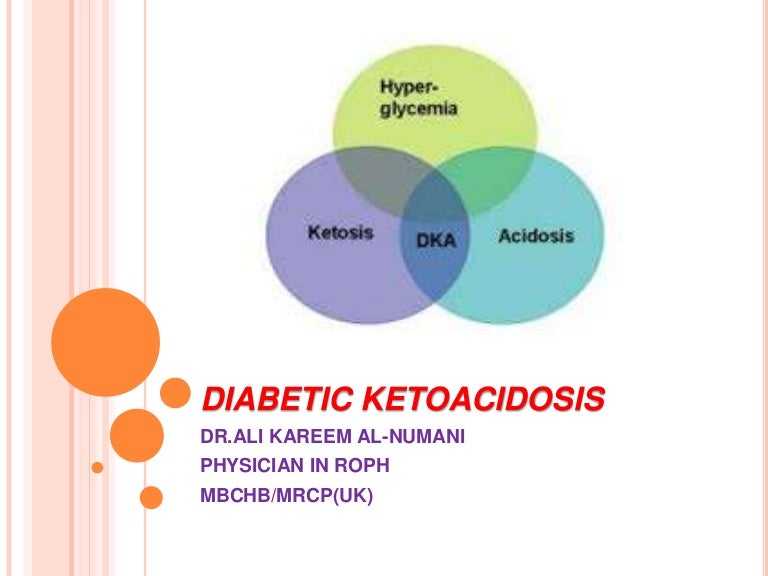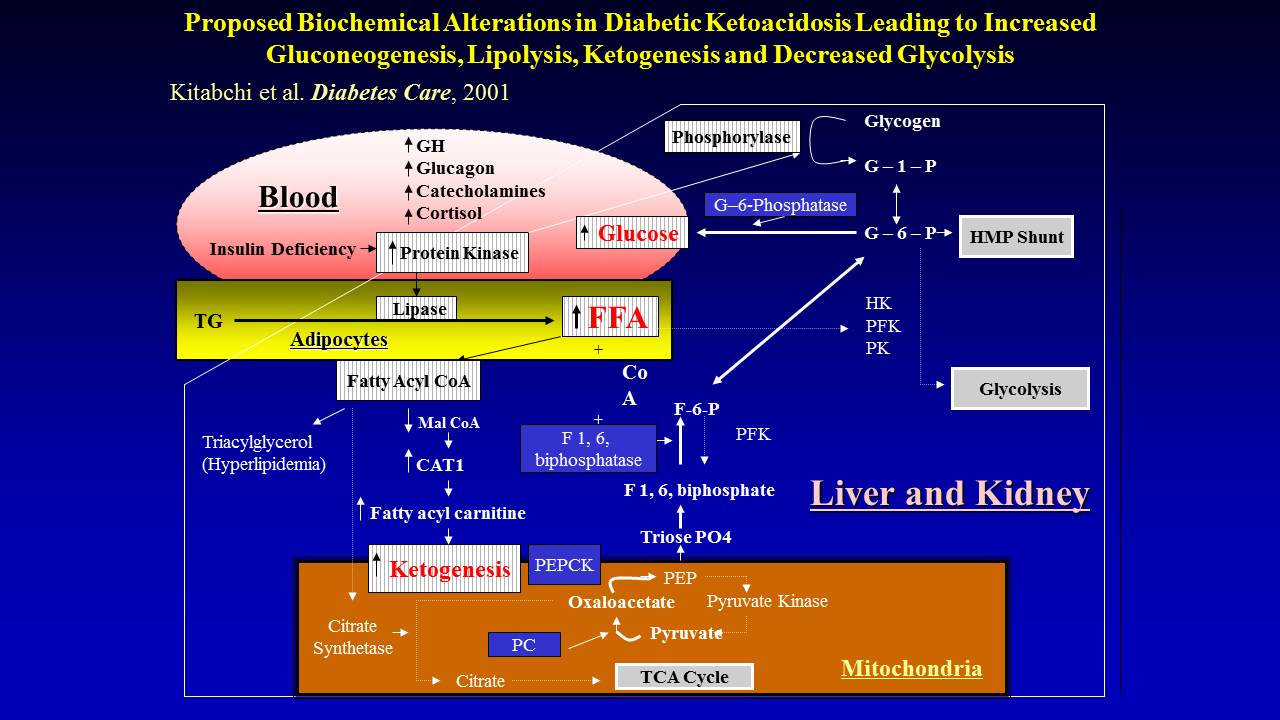Ketoacidosis Diabetes With
If your doctor suspects diabetic ketoacidosis, he or she will do a physical exam and order blood tests. in some cases, additional tests may be needed to help determine what triggered the diabetic ketoacidosis. blood tests. blood tests used in the diagnosis of diabetic ketoacidosis will measure:. Diabetic ketoacidosis is a potentially fatal complication of diabetes that occurs when you have much less insulin than your body needs. this problem causes the blood to become acidic and the body to become dangerously dehydrated. diabetic ketoacidosis can occur when diabetes is not treated adequately, or it can occur during times of serious. But ketoacidosis is a dangerous condition that happens when your body doesn’t have enough insulin and ketones build up too much. symptoms include excessive thirst, urinating often, confusion. not for use in people with type 1 diabetes or people with diabetic ketoacidosis it is not known if victoza ® can be control high blood sugar in adults and children with diabetes mellitus levemir ® is not meant for use to treat diabetic ketoacidosis important safety information do not share your levemir
The ketogenic diet for diabetes: is it good for diabetics?.
Diabetic Ketoacidosis Diagnosis And Treatment Mayo Clinic
If your doctor suspects diabetic ketoacidosis, he or she will do a physical exam and order blood tests. in some cases, additional tests may be needed to help determine what triggered the diabetic ketoacidosis. Feb 01, 2019 · diabetic ketoacidosis is a dangerous complication for people with diabetes. dka occurs when the body lacks insulin for too long, causing blood sugar to spike. dka can quickly become a medical. There's much you can do to prevent diabetic ketoacidosis and other diabetes complications. 1. commit to managing your diabetes. make healthy ketoacidosis diabetes with eating and physical activity part of your daily routine. take oral diabetes medications or insulin as directed. 2. monitor your blood sugar level. you might need to check and record your blood sugar level at least three to four times a day — more often if you're ill or under stress. careful monitoring is the only way to make sure your blood sugar level r Diabetic ketoacidosis requires treatment in a hospital, often in the intensive care unit. you will receive a large volume of fluids intravenously (through a vein) and insulin to lower your blood sugar and to correct the acidosis. your blood sugar and acid levels will be monitored frequently, and you will be given potassium supplements to restore your body's supply of this essential mineral. until your blood chemistry returns to normal, your vital signs (temperature, pulse, respirations, blood
Diabetic ketoacidosis occurs when your body doesn’t produce enough insulin. (diabetic ketoacidosis most often affects people with type 1 diabetes, but there is also type 2 diabetes ketoacidosis. If your doctor suspects diabetic ketoacidosis, he or she will do a physical exam and various blood tests. in some cases, additional tests may be needed to help determine what triggered the diabetic ketoacidosis. See full list on drugs. com.
Diabeticketoacidosis Medlineplus Medical Encyclopedia
Diabetic ketoacidosis symptoms and causes mayo clinic.

What Causes Diabetic Ketoacidosis Symptoms Complications
Diabetic Ketoacidosis Diagnosis And Treatment Mayo Clinic
A diagnosis of diabetic ketoacidosis requires the patient's plasma glucose concentration to be above 250 mg per dl (although it usually is much higher), the ph level to be less than 7. 30, and the. What is diabetic ketoacidosis? diabetic ketoacidosis, also known as dka, is a buildup of acids in your blood. it can happen when your blood sugar is too high for too long. dka is a serious. Diabetic ketoacidosis is a life-threatening complication of type 1 diabetes (though rare, it can occur in people with type 2 diabetes) that occurs when the body produces high levels of ketones due to lack of insulin. ; diabetic ketoacidosis occurs when the body cannot produce enough insulin. ; the signs and symptoms of diabetic ketoacidosis include.
Diabeticketoacidosis American Family Physician
Diabetic ketoacidosis is a life-threatening complication of type 1 diabetes (though rare, it can occur in people with type 2 diabetes) that occurs when the ketoacidosis diabetes with body produces high levels of ketones due to lack of insulin. diabetic ketoacidosis occurs when the body cannot produce enough insulin. the signs and symptoms of diabetic ketoacidosis include. Diabetic ketoacidosis is life-threatening. if you develop mild signs and symptoms, contact your doctor immediately. call 911 or your local emergency number if: 1. you can't reach your doctor 2. your symptoms are getting worse 3. your symptoms are already severea medical provider who sees you for possible diabetic ketoacidosis will need answers to these questions as quickly as possible: 1. what are your signs and symptoms? 2. when did these signs and symptoms develop? are they getting worse? 3.

See more videos for diabetes with ketoacidosis. Diabeticketoacidosis is characterized by a serum glucose level greater than 250 mg per dl, a ph less than 7. 3, a serum bicarbonate level less than 18 meq per l, an elevated serum ketone level.
Symptoms of diabetic ketoacidosis include: 1. frequent urination 2. extreme thirst 3. dry mouth 4. cool skin 5. nausea and vomiting with or without abdominal pain as blood ketone levels increase, the person's breathing pattern may become slow and deep, and his or her breath can have a fruity odor. a person with ketoacidosis may seem to be tired or confused or may have trouble paying attention. without prompt treatment in the first day of symptoms, the illness may cause low blood pressure, a l Symptoms of diabetic ketoacidosis can develop over a period of a few hours, and treatment results in rapid recovery. commonly, people who develop ketoacidosis will remain in the hospital for one to three days.
Diabetic ketoacidosis is a serious complication of diabetes that occurs when your body produces high levels of blood acids called ketones. the condition develops when your body can't produce enough insulin. insulin normally plays a key role in helping sugar (glucose) — a major source of energy for your muscles and other tissues — enter your cells. ketoacidosis diabetes with without enough insulin, your body begins to break down fat as fuel. this process produces a buildup of acids in the bloodstream called ketones, even See full list on mayoclinic. org. If you're diagnosed with diabetic ketoacidosis, you might be treated in the emergency room or admitted to the hospital. treatment usually involves: 1. fluid replacement. you'll receive fluids — either by mouth or through a vein (intravenously) — until you're rehydrated. the fluids will replace those you've lost through excessive urination, as well as help dilute the excess sugar in your blood. 2. electrolyte replacement. electrolytes are minerals in your blood that carry an electric charge, s See full list on mayoclinic. org.
Diabetic ketoacidosis is a serious complication of diabetes that occurs when your body produces high levels of blood acids called ketones. the condition develops when your body can't produce enough insulin. Sugar is a main source of energy for the cells that make up your muscles and other tissues. normally, insulin helps sugar enter your cells. without enough insulin, your body can't use sugar properly for energy. this prompts the release of hormones that break down fat as fuel, which produces acids known as ketones. excess ketones build up in the blood and eventually \\"spill over\\" into the urine. diabetic ketoacidosis is usually triggered by: 1. an illness. an infection or other illness can cause
Comments
Post a Comment